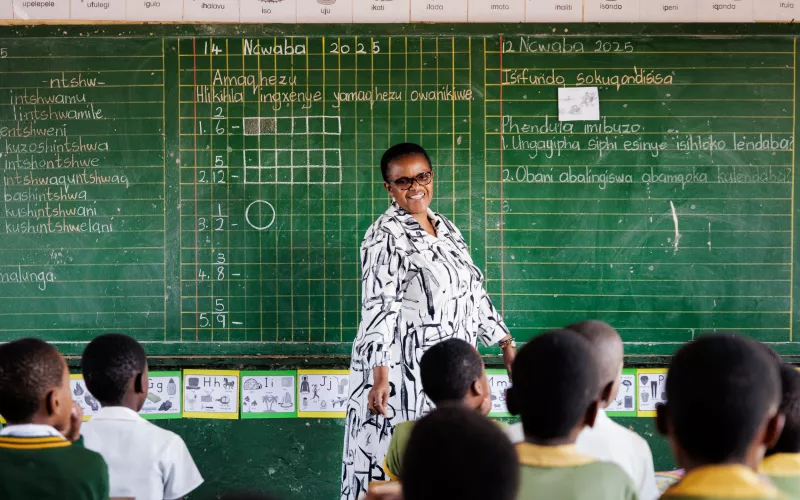
Why Gender-Responsive Pedagogy?
Persistent gender inequalities in classrooms affect participation, outcomes, and children’s overall learning experience. Globally, three-quarters of children of primary school age who may never set foot in school are girls. We cannot talk about equipping children with knowledge, skills, and attitudes to enable them to pursue education and live their limitless potential, without also addressing the challenges and barriers that hinder them from attaining this. Education must go hand in hand with tackling the stereotypes and social norms that limit children’s choices and futures.
Gender-Responsive Pedagogy (GRP) is teaching that gives every learner a fair chance to succeed. It shapes what is taught, how it is delivered and how learners retain knowledge. GRP helps teachers to recognise and address the gender norms that often play out in classrooms; norms that silence girls, penalise boys for showing vulnerability, or restrict children into rigid roles. It supports teachers to plan lessons, use language, and manage classrooms in an inclusive way.
When implemented effectively, GRP improves student attendance, engagement, and learning outcomes, particularly for girls. Teachers who model gender equity in class do not just change classroom dynamics; they also show learners that stereotypes can be challenged and new possibilities imagined. Over time, this helps shift community attitudes toward equity and fairness. That’s why teachers must be at the centre of curriculum design, system reforms and new initiatives.
The Case for Teacher Support in Inclusive Education
Teaching is central to Africa’s vision for education, reflected in the AU Agenda 2063 (The Africa We Want), Continental Education Strategy for Africa 2016-2025 and the Sustainable Development Goals (SDG 4 on Quality Education and SDG 5 on Gender Equality). Across Sub-Saharan Africa, political will is strong and billions are invested in education reforms every year. Yet without matching investment in teachers themselves, progress stalls. The continent continues to face challenges in insufficient teacher training, low morale and lack of recognition, which impedes the realisation of high-quality, inclusive and equitable education.
Insufficient teacher training in GRP, sees educators unintentionally reinforcing gender stereotypes in classrooms, such as calling on boys more in Science, Technology, Engineering and Maths (STEM) lessons or assigning domestic chores to girls. Research shows, however, that teachers who are trained in GRP and have a strong understanding of gender-sensitive teaching implement effective gender-inclusive practices despite educational systems and curricula that contain significant gender biases.
This is why the Regional Teachers Initiative for Africa (RTIA) works with VVOB – education for development, ENABEL, APEFE, UNESCO, African Union Commission, Forum for African Women Educationalists (FAWE), among others, to improve teacher training on gender-responsive pedagogy in Early Childhood, Primary, and Lower Secondary Education in Kenya, Ghana and South Africa. The initiative seeks to strengthen education systems and build a pool of competent and motivated teachers who can make a lasting impact on children’s futures globally.
Why Continuous Professional Training?
One of the biggest gaps in promoting GRP is the reliance on one-off trainings. A workshop may raise awareness, but it rarely reshapes the deep-seated attitudes, practices and resilience teachers need to sustain inclusive learning. What teachers require is continuous professional development (CPD) embedded in daily practice, supported by self-reflection and reinforced over time, alongside guidance from the broader school ecosystem.
In Sub-Saharan Africa, different models of GRP training have been tested:
- Pre-service integration, like Ghana’s Transforming Teacher Education and Learning (T-TEL programme), embeds GRP in initial teacher training colleges, though results take time.
- In-service cascade workshops (where trained teachers use their own training to train other teachers), used by Forum for African Women Educationalists (FAWE) and Kenya’s Centre for Mathematics, Science and Technology Education in Africa (CEMASTEA) reach many teachers cheaply, but often, leads to dilution of content as information is passed down.
- Coaching and mentoring, tried in Ghana, Uganda and Tanzania, provide tailored support, helping teachers change classroom practices such as grouping methods and language use.
Research shows that blended approaches work best, combining models such as pre-service training for future teachers, cascade workshops for quick reach, while incorporating coaching for lasting impact.
However, CPD alone is insufficient. Teachers also need emotional and peer support through coaching, mentorship and communities of practice, which help them continually challenge stereotypes. This approach aligns with the Bioecological Systems Theory, which highlights that teachers operate within larger ecosystems of institutions, traditions, and relationships that shape their beliefs and practices. A phased, school-based model of GRP training, reinforced by peer networks and mentoring, offers the most sustainable route to systemic change, moving beyond awareness to action. When teachers feel valued, supported and equipped, students benefit.
What Effective Implementation of Gender-Responsive Pedagogy Requires
Professional development must also include a focus on the skills or competencies teachers need to implement inclusive teaching effectively. Various studies highlight seven core competencies as essential for successful GRP practice:
- Teacher Self-Reflection and Knowledge (recognising and examining personal attitudes and bias)
- Gender Awareness (understanding gender stereotypes, norms, bias and the inequalities and discriminations that result from these)
- Planning and Organisation (designing inclusive lessons)
- Facilitation and Classroom Management (ensuring equitable participation and that every voice is heard)
- Curriculum and Materials Use (adapting materials to be gender-fair)
- Socio-Emotional Skills (supporting learners through challenges such as peer pressure)
- Community Advocacy (engaging families, leaders and community to extend gender equity beyond the classroom)
These essential competencies are what should guide the design of teacher professional development programmes across the region.
Which Way Then, for Effective Gender-Responsive Pedagogy?
For gender-responsive pedagogy to succeed, it must be embedded in national policies, teacher education and supportive professional development systems. As we approach the Pan African Conference on Teacher Education (PACTED 2025), it will be critical for all participants to share insights, challenges and opportunities to enhance teaching in Africa. Teachers hold the key to creating classrooms where every child, regardless of gender, can learn, lead, and dream without limits.